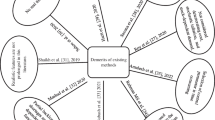Abstract
The purpose of this paper is to study a multi-item two warehouse inventory model with a nested discount on unit cost and inventory costs over a fixed time period. The concept of hybrid number and a new type of price discount have been applied in formulating an inventory control system having two separate storage facilities (owned-OW and rented-RW warehouses) due to limited capacity of OW. Here, demand rate is a linear function of selling price and time. The stocks at rented warehouse (RW) are transported to the owned warehouse (OW) following bulk-release rule. So, the mathematical model of the system becomes a constrained non-linear mixed-optimization problem. Here, taking the advantage of the randomness of multi-objective genetic algorithm with varying population (MOGAVP), for the first time, an algorithm has been proposed for the solution of multi-item two-warehouse inventory problems with nested price breaks. The optimum results are compared with MOGAVP and hybrid heuristic algorithm (HA). The optimal shipments, lot size of the two warehouses, shipment size and maximum profit are determined by maximizing the profit function. Finally optimal decision is made using above mentioned MOGAVP. Performance of the proposed MOGAVP on the model with respect to a standard MOGA and HA are compared.




Similar content being viewed by others
References
Abou-el-ata, O. M., & Kotb, K. A. M. (1997). Multi-item inventory model with varying holding costs under two restrictions: A geometric approach. Production Planning and Control, 8, 608–611.
Basten, R. J. I., van der Heijden, M. C., Schutten, J. M. J., & Kutanoglu, E. (2015). An approximate approach for the joint problem of level of repair analysis and spare parts stocking. Annals of Operations Research, 224, 121–145.
Ben-Daya, M., & Raouf, A. (1993). On the constrained multi-item single-period inventory problem. International Journal of Production Management, 13, 104–112.
Benton, E. C. (1985). Multiple price breaks and alternative purchase lot-sizing procedures in material requirements planning systems. International Journal of Production Research, 23, 1025–1047.
Bhunia, A. K., & Maiti, M. (1994). A two-warehouse inventory model for a linear trend in demand. Opserach, 31, 318–329.
Bhunia, A. K., & Maiti, M. (1997). A two warehouses inventory model for deteriorating items with linear trend in demand and shortages. Journal of Operational Research Society, 49, 287–292.
Chakraborty, D., Jana, D. K., & Roy, T. K. (2015). Multi-item integrated supply chain model for deteriorating items with stock dependent demand under fuzzy random and bifuzzy environments. Computers & Industrial Engineering, 88, 166–180.
Ghiami, Y., Williams, T., & Wua, Y. (2013). A two-echelon inventory model for a deteriorating item with stock-dependent demand, partial backlogging and capacity constraints. European Journal of Operational Research, 231, 587–597.
Hadley, G., & Whitin, T. M. (1963). Analysis of inventory systems. Englewood, Cliffs, NJ: Prentice Hall.
Hartely, R. V. (1976). Operations research–a managerial emphasis. Santa Monica, CA: Goodyear Publishing Company.
Jana, D. K., Das, B., & Maiti, M. (2014). Multi-item partial backlogging inventory models over random planninghorizon in random fuzzy environment. Applied Soft Computing, 21, 12–27.
Jana, D. K., Maity, K., & Roy, T. K. (2013). A three-layer supply chain integrated production-inventory model under permissible delay in payments in uncertain environments. Journal of Uncertainty Analysis and Applications, 1(1), 1–17.
Jana, D. K., Pramanik, S., Maiti, M. (2016). Mean and CV reduction methods on Gaussian type-2 fuzzy set and its application to a multilevel profit transportation problem in a two-stage supply chain network. Neural Computing and Applications, 1–24.
Liang, Y., & Zhou, F. (2011). A two-warehouse inventory model for deteriorating items under conditionally permissible delay in payment. Applied Mathematical Modelling, 35, 2221–2231.
Michalewicz, Z. (2009). Genetic algorithms + data structures = evolution programs, Springer(Indian) Private Ltd., (Chapter 2 & 3).
Panda, D., Kar, S., & Maiti, M. (2008). Multi-item EOQ model with hybrid cost parameters under fuzzy/fuzzy-stochastic resource constraints: A geometric programming approach. Computers & Mathematics with Applications, 56(11), 2970–2985.
Rong, M., Mahapatra, N. K., & Maiti, M. (2008). A two warehouse inventory model for a deteriorating item with partially/fully backlogged shortage and fuzzy lead time. European Journal of Operational Research, 189, 59–75.
Sarkar, B., Saren, S., & Crdenas-Barrn, L. E. (2014). An inventory model with trade-credit policy and variable deterioration for fixed lifetime products. Annals of Operations Research,. doi:10.1007/s10479-014-1745-9.
Sarma, K. V. S. (1987). A deterministic order-level inventory model for deteriorating items with two storage facilities. European Journal of Operational Research, 29, 70–72.
Silver, E. A. (1979). A simple inventory decision rule for a linear trend in demand. Journal of Operational Research Society, 30, 71–75.
Tsai, C., Tsai, C., & Tseng, C. (2004). A new hybrid heuristic approach for solving large traveling salesman problem. Information Sciences, 166, 67–81.
Yanlai, L., & Fangming, Z. (2011). A two-warehouse inventory model for deteriorating items under conditionally permissible delay in payment. Applied Mathematical Modelling, 35, 2221–2231.
Zadeh, L. A. (1965). Fuzzy sets. Information and Control, 8, 338–353.
Author information
Authors and Affiliations
Corresponding author
Rights and permissions
About this article
Cite this article
Jana, D.K., Das, B. A two-storage multi-item inventory model with hybrid number and nested price discount via hybrid heuristic algorithm. Ann Oper Res 248, 281–304 (2017). https://doi.org/10.1007/s10479-016-2162-z
Published:
Issue Date:
DOI: https://doi.org/10.1007/s10479-016-2162-z




